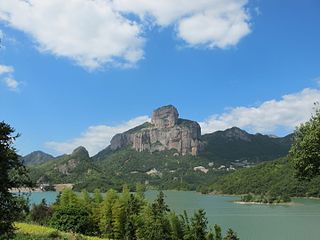
Zhejiang is an eastern coastal province of the People's Republic of China. Its capital and largest city is Hangzhou, and other notable cities include Ningbo and Wenzhou. Zhejiang is bordered by Jiangsu and Shanghai to the north, Anhui to the northwest, Jiangxi to the west and Fujian to the south. To the east is the East China Sea, beyond which lies the Ryukyu Islands. The population of Zhejiang stands at 64.6 million, the 8th largest in China. It has been called "the backbone of China" because it is a major driving force in the Chinese economy and being the birthplace of several notable people, including the Chinese Nationalist leader Chiang Kai-shek and entrepreneur Jack Ma. Zhejiang consists of 90 counties.

Wenzhou, historically known as Wenchow is a prefecture-level city in China's Zhejiang province. Wenzhou is located at the extreme southeast of Zhejiang, bordering Lishui to the west, Taizhou to the north, and the province of Fujian to the south. The area consists of mostly mountainous terrain, as well as hundreds of islands off the East China Sea coast, which is nearly 355 kilometres in length. It is said that the city's land is 70% mountains, 20% farmland, and 10% water. At the time of the 2010 Chinese census, 3,039,500 people lived in Wenzhou's urban area. The greater Wenzhou prefecture, which also includes three satellite cities and six counties, had a population totalling 9,122,100, of which 31.16% are residents originally from outside of Wenzhou.

Wu is a major group of Sinitic languages spoken primarily in Shanghai, Zhejiang Province, and the part of Jiangsu Province south of the Yangtze River, which makes up the cultural region of Wu. Speakers of various Wu languages sometimes labelled their mother tongue as Shanghainese when introduced to foreigners. The Suzhou dialect was the prestige dialect of Wu as of the 19th century, but had been replaced in status by Shanghainese by the turn of the 20th century. The languages of Northern Wu are mutually intelligible with each other, while those of Southern Wu are not.
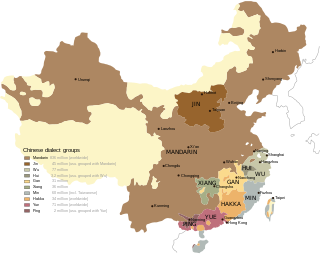
The Sinitic languages, often synonymous with the Chinese languages, are a group of East Asian analytic languages that constitute a major branch of the Sino-Tibetan language family. It is frequently proposed that there is a primary split between the Sinitic languages and the rest of the family. This view is rejected by a number of researchers but has found phylogenetic support among others. The Greater Bai languages, whose classification is difficult, may be an offshoot of Old Chinese and thus Sinitic; otherwise Sinitic is defined only by the many varieties of Chinese unified by a shared historical background, and usage of the term "Sinitic" may reflect the linguistic view that Chinese constitutes a family of distinct languages, rather than variants of a single language.
The Danzhou dialect, locally known as Xianghua, is a Chinese variety of uncertain affiliation spoken in the area of Danzhou in northwestern Hainan, China. It was classified as Yue in the Language Atlas of China, but in more recent work, it is treated as an unclassified southern variety.
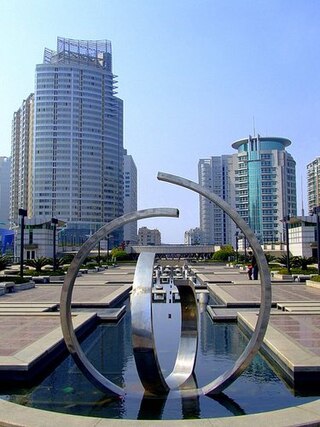
Rui'an is a county-level city along the southern coast of Zhejiang province, China, and is under the administration of Wenzhou City. It has a population of 1,125,000 people and covers a land area of 1,271 km2 (491 sq mi), 3,037 km2 (1,173 sq mi) when including water area. Natives of the city speak the Rui'an dialect of Wu Chinese.

Lucheng District is a district of the city of Wenzhou, Zhejiang province, China. It is the central district and government seat of Wenzhou.

Ouhai District is a district of Wenzhou, Zhejiang. It is an outlying district of Wenzhou urban area.
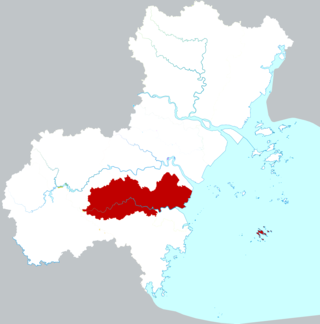
Pingyang County is a county in the prefecture-level city of Wenzhou, located along the southern coast of Zhejiang province, China. There are two main cities with many surrounding villages in Pingyang. The two main settlements are called Aojiang and Kunyang. Aojiang is located ten minutes outside of Kunyang and the various villages and area's that are also classified as part of Pingyang county extend for about a 1-hour radius.
Wenzhounese, also known as Oujiang, Tong Au or Au Nyü, is the language spoken in Wenzhou, the southern prefecture of Zhejiang, China. It is the most divergent division of Wu Chinese, with little to no mutual intelligibility with other Wu dialects or any other variety of Chinese. It features noticeable elements in common with Min Chinese, which is spoken to the south in Fujian. Oujiang is sometimes used as the broader term, and Wenzhou for Wenzhounese proper in a narrow sense.
The Wu Chinese people, also known as Wuyue people, Jiang-Zhe people (江浙民系) or San Kiang (三江), are a major subgroup of the Han Chinese. They are a Wu Chinese-speaking people who hail from southern Jiangsu Province, the entirety of the city of Shanghai and all of Zhejiang Province, as well as smaller populations in Xuancheng prefecture-level city in southern Anhui Province, Shangrao, Guangfeng and Yushan counties of northeastern Jiangxi Province and some parts of Pucheng County in northern Fujian Province.

Qingtian, is a county in southeastern Zhejiang Province, on the middle-lower reaches of the Ou River which flows 388 kilometers (241 mi) before finally reaching the city of Wenzhou and emptying into the East China Sea. Around 80% of all the Chinese people living in Spain comes from this small area. The county is known from AD 711 on and was named for its rich rice paddy fields. Subtropical monsoon climate: annual average temperature 18.3 °C (64.9 °F), annual rainfall 1,747 mm (68.8 in). Hilly territory with many ravines. Its capital is Hecheng, also known as Qingtian City. The inhabitants speak Wenzhounese and Qingtianese, both Wu dialects.
Romanisation of the Wenzhou dialect of Wu Chinese, part of the greater Ōu grouping of Wu dialects centred on the city, refers to the use of the Latin alphabet to represent the sounds of the dialect group.
Wenzhou Zhouyuan Elementary School is a private elementary school in Wenzhou, China. Since its establishment, it has been one of the most prestigious elementary schools in China and also serves as a "model school" in many areas of education for elementary schools all across China.
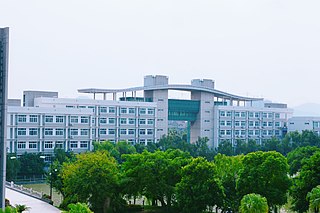
The Zhejiang Wenzhou High School (simplified Chinese: 浙江省温州中学; traditional Chinese: 浙江省溫州中學; pinyin: zhè jiāng shěng wēn zhōu zhōng xué ), known colloquially as Wenyizhong (WZHS), is a public senior high school located in Wenzhou, Zhejiang, China. WZHS is situated in the Ouhai District of Wenzhou, within the Sanyang Wetland Scenic Area. It is one of the first provincial first-class high schools and first provincial first-class ordinary high school model schools established by the Department of Education of Zhejiang Province. Wenzhou High School is known as the "cradle of mathematicians" for educating many famous mathematicians, such as Su Buqing and Gu Chaohao. Among the best schools in China in 2015, Zhejiang Wenzhou High School is ranked 46.
Shehua is an unclassified Sinitic language spoken by the She people of Southeastern China. It is also called Shanha, San-hak (山哈) or Shanhahua (山哈话). Shehua speakers are located mainly in Fujian and Zhejiang provinces of Southeastern China, with smaller numbers of speakers in a few locations of Jiangxi, Guangdong and Anhui provinces.

Longgang is a county-level city of Zhejiang, China. As of 2018, its population was 378,000, spread across 183.99 km2 (71.04 sq mi) divided into 14 neighborhoods, 22 residential areas, and 171 villages. Longgang is administered as a part of the prefecture-level city of Wenzhou, whose downtown is about 70 kilometers (43 mi) away.
Dihua Jiang is a Chinese-born American mathematician. He is a professor of mathematics at the University of Minnesota working in number theory, automorphic forms, and the Langlands program.
Jinxiang is a town under the jurisdiction of Cangnan County, Wenzhou, Zhejiang Province, People's Republic of China, bordered by the East China Sea, located at the junction of Zhejiang and Fujian, with an area of 43.55 square kilometers. Jinxiang dialect is spoken mainly in the town, and the "Man" dialects and Minnan dialects are spoken in some rural areas. Jinxiang is surrounded by mountains on three sides and the sea outside the mountains. It is originally a rocky reef area made of coastal sand and alluvial soil.

Wenzhou railway station is a railway station in Lucheng District, Wenzhou, Zhejiang, China. It is the eastern terminus for passenger services on the Jinhua–Wenzhou railway. It opened with the line on 11 June 1998.













